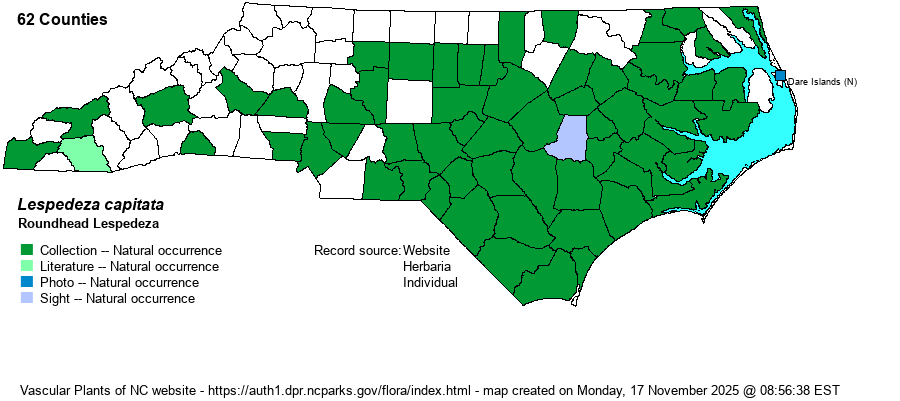| Author | Michaux | |
| Distribution | Throughout the Coastal Plain and the eastern half of the Piedmont; of spotty occurrence in the southwestern Piedmont; a few records for the Mountains. May well be absent from the northern Mountains and far northwestern Piedmont.
This is a wide-ranging Eastern species, from extreme southern Canada south to northern FL and eastern TX. However, it is scarce in montane regions such as the Appalachians. | |
| Abundance | Very common in most of the Coastal Plain, except fairly common to common in northern counties. Common in the eastern Piedmont, fairly common in central sections, and generally uncommon in the southwestern portions. Very rare in the lower elevation Mountains, with only a handful of known records. | |
| Habitat | This lespedeza occurs in the same places where most others in the genus occur -- wooded borders, edges, thickets, powerline clearings, and other brushy places; however, unlike some, it tends to favor somewhat damp soil as opposed to overly dry or sandy soil. It also occurs in damp meadows, sandhills ecotones such as streamheads, and other somewhat sunny and damp ground. | |
| Phenology | Blooms from August to October, and fruits from September to November. | |
| Identification | This is a quite familiar Lespedeza, and is perhaps the most often seen native species, at least in the eastern half of the state. It has a rather wand-like appearance, with no or only a few short branches, which are strongly ascending and close to the main stem. It grows to 3-4 feet tall and has an abundamce of appressed hairs on the stem. The leaves are on short petioles (barely 1/8-inch long), bearing 3 leaflets that are narrowly elliptic, about 1.2 inches long and only 2/5-inch wide, clearly wider than on the similar L. angustifolia, whose leaflets are mainly parallel-sided and narrower. The leaflet surfaces are very "silvery" owing to an abundance of dense whitish and appressed hairs, and thus the plant at a distance is quite glaucous and pale. As with L. angustifolia, the inflorescences are in small but very dense racemes (looking like heads) of small flowers, near or at the top of the stem; the flowers are creamy white with a purple spot on the standard and about 2/5-inch long. Even without the flower "heads", the silvery look of the leaflets, which are elliptical in shape and not linear, should easily identify this plant. In some parts of the range, more so in the Sandhills, the species is more often found along streamheads and seepages, but in much of the Piedmont and northern Coastal Plain it is found in powerline clearings and other sunny and "grassy" places, particularly where slightly damp. | |
| Taxonomic Comments | None
| |
| Other Common Name(s) | Roundhead Bush-clover | |
| State Rank | S4? [S5] | |
| Global Rank | G5 | |
| State Status | | |
| US Status | | |
| USACE-agcp | FACU link |
| USACE-emp | FACU link |

